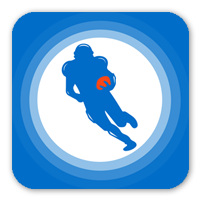What is Pull% (pull percentage) for hitters? Definition and meaning of Pull% as part of our sabermetrics glossary for fantasy baseball.
Welcome RotoBallers to our overview of Pull%. This article is a deeper dive into Pull% and is part of our ongoing series "Using Sabermetrics for Fantasy Baseball."
In this article, we'll explore how Pull% works including the benefits of pulling fly balls and the downsides of pulling grounders using easy language anybody can understand. We'll also see why raw Pull% is useless without batted ball type.
You can find our entire sabermetrics glossary, which includes links to many other sabermetric stats as part of this series. Each stat deep dive will be released over the next few days. Stay tuned!
Be sure to check all of our fantasy baseball lineup tools and resources:- Fantasy baseball trade analyzer
- BvP matchups data (Batter vs. Pitcher)
- PvB matchups data (Pitcher vs. Batter)
- Who should I start? Fantasy baseball comparisons
- Daily MLB starting lineups
- Fantasy baseball closer depth charts
- Fantasy Baseball live scoreboard
- Fantasy baseball injury reports
What Is Pull%? Sabermetrics Glossary
Fantasy managers generally prefer batters to hit the ball into the air to have a chance at a home run. Yet, all fly balls are not equal for this purpose. A player can maximize power production by pulling the ball in the air.
One way to illustrate this is to look at league-wide HR/FB by batted ball direction. Flies to the opposite field seldom became HR in 2024, posting a HR/FB of just 3.3 percent. Flies to dead center fared slightly better (7.2 percent HR/FB), but pulled fly balls were the most productive (30.8 percent HR/FB). The exact numbers vary annually, but every season illustrates this trend.
Raw Pull% is found on the Batted Ball graph on a player's FanGraphs page fifth from the top, but that number is virtually useless. Pull% has to be considered by batted ball type (grounder, fly, or liner) to be useful, forcing managers to turn to the second of three tables under the Splits tab at the top. Here's a closer look at how Pull% can help you with draft prep!
How To Interpret Pull%
In 2024, there were a total of 5,453 homers hit. Of those, 3,675 went to the batter's pull side (about 67 percent), 1,181 went to center field (22 percent), and the remaining 597 were opposite-field shots (11 percent). This distribution is fairly consistent year-to-year, so it's safe to count on something similar going forward.
This makes intuitive sense. Pulled baseballs generally have the highest exit velocity, making it easier for them to leave the stadium. The power alleys next to the foul poles on either side of the ballpark also present the shortest distance. If a player's HR/FB dramatically improves, a change in approach involving more pulled baseballs could help explain why.
Ketel Marte provides a good illustration of this kind of change. Marte set personal full-season bests with 36 HR and a 25.7 percent HR/FB last year. An increased Pull% on fly balls helps explain this change as he pulled 33.6 percent against a career rate of 26.1 percent.
The number of fly balls a batter pulls is prone to random fluctuations and may not indicate anything with predictive value. Xander Bogaerts appeared in this space in the past, and his Pull% on fly balls is a random number generator.
Still, a higher Pull% on fly balls can help explain why a power outbreak happened and could prove sustainable if the batter continues to pull flies.
Did The Shift Ban Work?
Pulled flies are good, but many fantasy managers cringe when they hear "pull" because they envision infield shifts eating their batting average alive. Rob Manfred banned shifts before the 2023 campaign, and now it's time to quantify what that did.
At first glance, Manfred won. MLB hitters hit .300 against the shift in 2023, up from .288 in 2022. MLB hitters hit .299 without a shift in 2023, down from .303 in 2022. However, 2024 was a little different, with hitters hitting .292 against the shift and .297 without it.
Teams adapted their infield alignments to create more effective shifts within the new rules, but Manfred's win in 2023 wasn't as big as initially portrayed.
FanGraphs always categorized shifts as "traditional" or "non-traditional." Traditional shifts limited MLB hitters to a .282 average over 66,942 PAs in 2022. The new rules reduced their effectiveness, and hitters hit .294 in 65,786 PAs against traditional shifts in 2023. That fell to .286 in 71,381 PAs last season.
Non-traditional shifts were never effective, as batters hit .348 against them across 7,725 PAs in 2022. The new rules rendered them even less effective, with 2023 batters hitting .375 in 6,631 PAs and 2024 batters .364 in 7,043 PAs. Wildly ineffective non-traditional shifts skew the overall shift numbers.
Extreme-pull guys will lose hits to infield shifts going forward. Shifts should still be a consideration in batting average forecasts.
The Problem With Raw Pull%
Of all pulled baseballs in 2024, 56.6 percent were grounders. Pulled grounders might have a higher average exit velocity than other ground balls, but they will never turn into home runs. In contrast, only 23.6 percent of pulled baseballs were classified as fly balls last season. Fantasy managers want their hitters to pull flies while limiting how often they roll grounders to their pull side.
This is much easier said than done, as all players pull more grounders than flies. Let's consider Bobby Witt Jr. as an example again. His raw 2024 Pull% of 35.1 percent was lower than the league-average 40.6 percent, but he pulled 48.7 percent of his grounders compared to 20.9 percent of his flies.
At first glance, you might think Witt was making himself vulnerable to shifting without significantly boosting his power potential. That assumption would be wrong.
The traditional shift was designed for batters who pull roughly 70 percent of their ground balls, and Witt scorched it for a .362 average in 268 PAs last year. He "only" hit .339 in 229 PAs without a shift, making Witt a guy who should see fewer shifts in the future.
Witt's Pull% on flies was slightly lower than the league's mark of 23.6 percent, but he has enough raw power to overcome that. Pulling more grounders than flies is far from a death sentence.
Conclusion
To sum up, pulled fly balls tend to perform better than other fly balls. It can produce an increased HR/FB, but you should never use raw Pull% to determine this. Most pulled balls are hit on the ground, where all of the exit velocity in the world cannot turn them into home runs.
Therefore, you should filter a player's Pull% by batted ball type to produce the most reliable results.
Download Our Free News & Alerts Mobile App
Like what you see? Download our updated fantasy baseball app for iPhone and Android with 24x7 player news, injury alerts, sleepers, prospects & more. All free!

More Fantasy Baseball Advice





 RADIO
RADIO
























